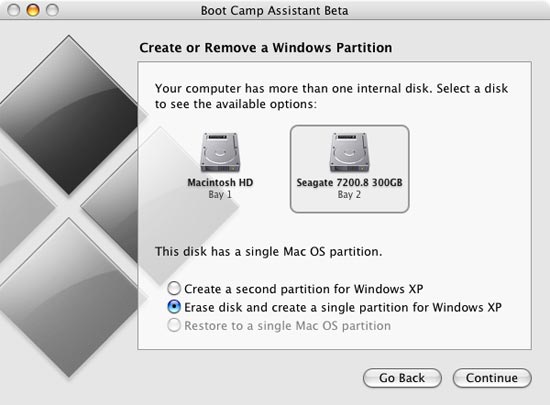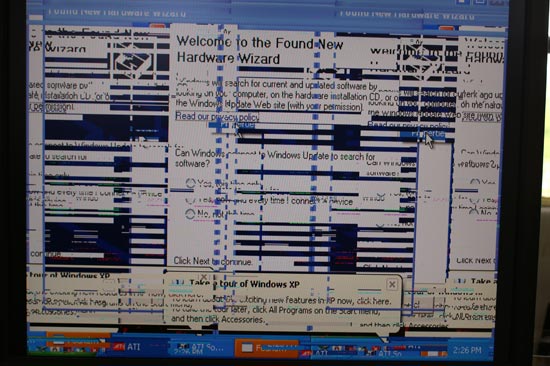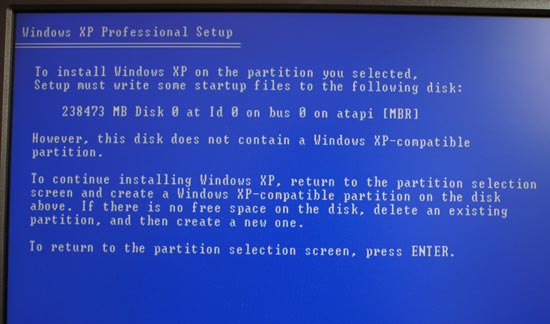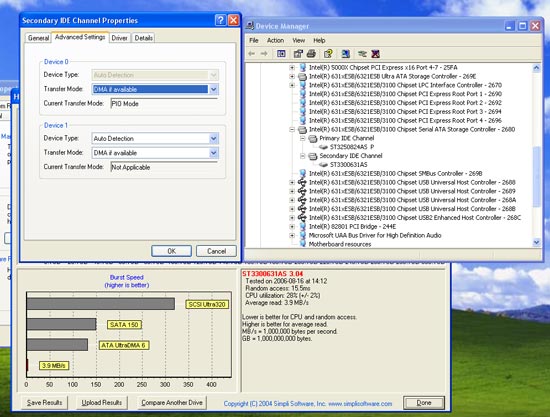Apple's Mac Pro - Upgrading CPUs, Memory & Running XP
by Anand Lal Shimpi on September 12, 2006 1:51 AM EST- Posted in
- Mac
Installing Windows XP, the Right Way
When we first reviewed the Mac Pro, we of course tried to install Windows XP on it.

Although Apple's Bootcamp beta now allows you to install Windows on a separate hard drive, you'll need to physically remove your OS X boot drive before beginning the install process otherwise you'll be greeted with the following error:
Even with Apple's updated Bootcamp 1.1 beta release, we encountered serious performance issues with SATA drives under XP; the fastest transfer rate attainable, regardless of drive used, was only 3.9MB/s, which obviously made the system very slow. Video and CPU performance was fine, but with I/O performance so low the system was a very poor performer in most applications.
Thankfully, some clever OS X/XP users figured out the cause of the problem: the Intel 5000X drivers must be slipstreamed into the Windows XP SP2 install CD and loaded during Windows setup, not after, in order to avoid the problem. We couldn't find a reason why this was true, but after following the instructions posted here (and later mirrored here) our SATA problems went away.
The fix is simple; you need to download and extract the Intel chipset drivers for the 5000X, as well as the SATA drivers, and use a tool such as nLite to slipstream the drivers into your XP SP2 install CD.
If you've done it correctly, your SATA drives should now operate in Multi-Word DMA Mode 2 instead of PIO Mode when viewed in Device Manager.
With Windows XP now working at full speed on the Mac Pro, we run into another hurdle in making the Mac Pro the perfect XP/OS X workstation: the video card. Apple only offers three video card options for the Mac Pro: a GeForce 7300 GT, Quadro FX 4500 and a Radeon X1900 XT. The problem is that the first option is a fairly low end GPU, and the remaining two are fairly expensive upgrades at $499 and $399 respectively. It would be much nicer if we could simply use a PC video card in the system, as it would greatly expand the possibilities for upgrades and do so at much better prices.
PC video cards will actually work in the Mac Pro under Windows XP, they will not however work under OS X or during any of the pre-boot period of starting the machine (e.g. you will not be able to see the startup disk selection screen if you hold down the Option key while the system starts). If you install a PC video card in the Mac Pro you'll simply get a black screen until Windows starts loading, at which point everything will look normal. We used this fact to our benefit by running all of our Windows XP game tests with a regular ATI Radeon X1900 XTX. Interestingly enough, when we tried to use a Radeon X1900 XT 256MB, we got a lot of display corruption as you can see from the screenshot below:

We couldn't do anything to get rid of the corruption, and aren't sure why it happened only with the 256MB X1900 XT.
On the OS X side, if you try to boot with a PC video card you'll simply get a black screen from start to finish. We've tried ATI's Radeon X1900 XT as well as the new GeForce 7900 GS (the GPU supports OS X, but the cards themselves do not) and had no luck in OS X. As soon as Mac versions of these cards are readily available, users should be able to rip the firmware off of one and work on putting it onto a PC card. Until then, your video card selection for the Mac Pro is going to be quite limited.












72 Comments
View All Comments
bobsmith1492 - Tuesday, September 12, 2006 - link
Well, thank you for the enlightenment. I will never use Vista now that I know I cannot use more than 64GB of RAM.blwest - Tuesday, September 12, 2006 - link
Who did that comment come from, something about never needing more than 64K? Was it Bill Gates?I already have customers that use Linux over MS because they utilize 64GB of ram TODAY. Even when Vista is released, they will still be using Linux.
bobsmith1492 - Tuesday, September 12, 2006 - link
Well, I've doubled the amount of ram in my _personal_ computer twice in about 5 years along with one upgrade of Windows (98-XP)... so, in 5 more, I'll have 8GB, 10 more: 32, and in about 12.5 years, I'll be up to 64GB, by extrapolation. :P Anyway, I don't expect Vista to last that long, so I guess I'm ok (heck, I'll use XP for a few more years anyway, no doubt - XP was out for a few years before I upgraded).As far as the 64GB of RAM, if you need that for your application, you probably wouldn't even dream of using a closed-source OS for it anyway, so I think the RAM limitation isn't really that relevant (maybe for servers...)
greylica - Tuesday, September 12, 2006 - link
Course the common user will not have to use that quantity of Ram, as far as I know, they are still using 256MB at nmaximun in order to run only apps for office/small production.Here in Brazil the most of them are using at maximun 512 MB of Ram, but when we think in a machine different, like a MAc, or then a graphic Workstation, or then an data seismic or a test evaluation machine, 64 GB in 5 years will be a cap, a limit.
Anyway Linux can save our souls to this switch Microsoft is trying to do again, and again...
A simpler crowd simulation in XSI can achieve 16 GB of Ram in a workstation...
Vista Premium can accept more than 4GB, course, but in the 32 bit usage, the same old 3GB switch is aplicable, but I don´t even imagine why they at the same tima reserve 4GB for the kernel, and limit Vista to 1/2 of the potential.
It´s a same old problem coming back again.
Even 2000 accepts PAE, but doesn´t serve for nothing, course they can give a patch, but, do they want ???
If a patch for ths issue is released, this topic can be sent to oblivion.
Microsoft, give us a patch to 3GB switch right now !!!!!!
mostlyprudent - Tuesday, September 12, 2006 - link
I have to agree with the first part of your post. I read the article and thought.."Why?". I have always understood the appeal of a Mac to be that you could upack it and get to work. If we start talking about running other OSs on a Mac or hacking software/drivers for better hardware supprt, then why pay the premium for a Mac?lopri - Tuesday, September 12, 2006 - link
Well, sort of.. Remember that now Mac is a PC with the ability to dual-boot between XP and OS X. Other than the anatomy description for CPU upgrading, I don't see anything Mac-specific about this article. You can replace the tested Mac with an equivalent workstation from Dell, HP, etc. and the end result would be the same. It's also very questionable how much appeal this article would have to an 'average' apple user - who wants a computer that just works, without worrying about upgrading or fixing, and prefers to use for creative works or entertainment. (This isn't my opinion, btw. I happened to read a few articles on Apple/Mac @DailyTech, and it's how Mac users described themselves) I totally understand this article is a sequel/finale to a previous article, but I think some people would agree with me. (If not, oh well.. :) )From this viewpoint, I'd like to make a comment that Anand's obsession on Apple (be it hardware or software) has been quite over-the-top already. Even though this article isn't really about something unique to Apple, he doesn't skip a single product that Apple produces. (I still can't believe he "reviewed" a mouse just because it's from Apple. There are many more superior and innovative mice in the market, you know.)
Whether it's his personal preference towards Mac/OS X or a business strategy to expand the readership of this site isn't clear to me. But I can't help but notice the imbalance and ask why.
Anand Lal Shimpi - Tuesday, September 12, 2006 - link
The point of the article was for users that want to run OS X as well as Windows XP, rounding out the performance comparison by showing what sort of XP performance you can expect out of the Mac Pro.As for our Mac coverage, we definitely don't review every Apple product that comes out, but the ones that we do focus on are those that are most interesting to the community. The vast majority of our content is still PC focused, but whenever there's a big Apple release we will do our best to cover it just as we do major releases on the PC side.
Take care,
Anand
JAS - Thursday, September 14, 2006 - link
PC = Personal Computer, regardless of whether it is running OS X or Microsoft Windows.Please continue with the Macintosh coverage, Anand. I appreciate the excellent work that you do, and even bought a Mac because of one of your reviews. What a fabulous computer.
Calin - Tuesday, September 12, 2006 - link
:)I'm sure Anand wants to expand the readership of his site to the 5% Mac users :)
(no offence, Anand) but I think this was more like a toy, that is getting better and better. "I bet I could use only this Mac for everything" could have been the idea of the first article, and in the end it seems the Macs were even better than that (whether by look and feel, ergonomy in user interface, invulnerability to almost all viruses/worms/... (the first Mac used by Anand was Power based), other reasons or a combination of all the above).
On another note, I wonder how well those new Macs will survive in the virus world, now that they now have the x86 processors
JAS - Thursday, September 14, 2006 - link
If you mean running Microsoft Windows on a Macintosh, then it is as susceptible to spyware and viruses as any other MS Windows computer. These problems are tied to the operating system, not the microprocessor. OS X is as secure running on Intel as it is on PowerPC chips.